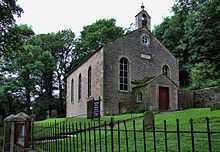Low Row
- Not to be confused with the village near Brampton, Carlisle, Cumbria, or with the road in Cwmpennar.
Coordinates: 54°22′33″N 2°01′51″W / 54.37593°N 2.03088°W
Low Row is a village in Swaledale, in the Yorkshire Dales, North Yorkshire, England. It lies about 3 miles west of Reeth and is between Healaugh and Gunnerside. It is part of the Richmondshire parish Melbecks. It is a linear village running along one road, the B6270.[1] To the east, Low Row merges with the settlement of Feetham.
A working farm, Hazel Brow Farm, is open to visitors and 'The Punch Bowl', a stone inn dated 1638, is by the main road.[2]
History
The name Low Row comes from the Norse "The Wra" (a nook).[3] The surname "Raw" is associated with the village.[4] The village was raided by Jacobites in 1745, and bodies probably from that raid are buried at the church in Low Row.[2]
On 5 July 2014, the Tour de France Stage 1 from Leeds to Harrogate passed through the village.[5]
Smarber Chapel and Low Row United Reformed Church

Philip, Lord Wharton,[6] owned land in the area. On this stood a number of shooting lodges including one at Crackpot, near Keld, and one at Smarber, a small hamlet on the ridge to the west of Low Row. A Puritan sympathiser, in around 1690 Wharton converted part of the Smarber lodge into a chapel for ‘ Protestant Dissenters’.[7] He particularly had the needs of the local lead miners in mind.
It was a small, simple building; the lower part of the dry-stone wall remains and shows evidence of plaster and the location of a window. At the east end, an adjoining barn still stands. This also shows traces of plaster and windows and is considered[8] originally to have been a cottage attached to the chapel. It is known[9][10] that Wharton bought land near Kirkby Stephen, the income from which was to support a minister at Smarber.

In 1809 a new chapel was built, beside the road at the west end of Low Row, and the former building fell into disrepair. Having originally tended to favour the Presbyterian position, the chapel declared itself Congregational in 1867, during the 50-year ministry of John Boyd.[11] He also supervised a major rebuild in 1874. This cost over £300 and resulted in the building as seen today.[12] Now part of the United Reformed Church, an active congregation continues to worship in the chapel and ‘pilgrimages’ to the former building take place from time to time.[13]
References
- ↑ Smith, Roly (2008). Swaledale. Frances Lincoln Ltd. p. 49. ISBN 0-7112-2636-9.
- ↑ 2.0 2.1 Scholes, Ron (2006). Yorkshire Dales. Landmark Visitor Guide. Hunter Publishing Inc. p. 145. ISBN 1-84306-209-7.
- ↑ Fleming, Andrew (1998). Swaledale: valley of the wild river. Edinburgh University Press. p. 47. ISBN 1-85331-197-9.
- ↑ Ucko, Peter J.; Layton, Robert (2004). The Archaeology and Anthropology of Landscape: Shaping Your Landscape. Routledge. p. 0203202449.
- ↑ "Tour de France Stage 1". Retrieved 15 July 2014.
- ↑ Wadsworth, K W, Philip, Lord Wharton – Revolutionary Aristocrat? Journal of the United Reformed Church History Society Volume 4 No 8 May 1991(being the 1990 Annual Lecture of the Society)
- ↑ Stell, Christopher An inventory of nonconformist chapels and meeting-houses in the north of England 1994 Page 215
- ↑ Historic England. "Monument No. 595356". PastScape. Retrieved 21 September 2014.
- ↑ Dale, Bryan, The Good Lord Wharton, revised edition 1906
- ↑ Whitehead, T. History of the Dales Congregational Churches, Keighley 1930. p.151.
- ↑ The Christian World 27 August 1875
- ↑ A Church Renewed, Low Row United Reformed Church, 1974
- ↑ Conran, Elizabeth, Dissent in the Two Dales 1662–2012, 2012
External links
![]() Media related to Low Row at Wikimedia Commons
Media related to Low Row at Wikimedia Commons

